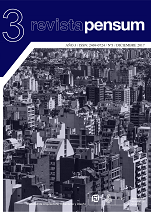UTOPIA AND POWER IN THE CITY OF THE RENAISSANCE. THE THEORIES OF MORO AND CAMPANELLA IN THE URBAN PROPOSALS
DOI:
https://doi.org/10.59047/2469.0724.v3.n3.19015Keywords:
Architecture, Cities, PhilosophyAbstract
The philosophical approaches made by Sir Thomas More in Utopia and TommasoCampanella in The City of the Sun are the starting point of this writing. It seeks to reflect on utopia and power in Renaissance urban proposals.It will be noted that the Renaissance city-ideal, creation more intellectual than real, was a further consequence of Utopian Renaissance thought. In addition, it will be shown that many of the urban ideas of the Renaissance, which did not go beyond doctrine, utopia or ideal exercise of the intellect in the countries of Europe where they originated, had their real materialization field in America. The writing begins by attending to the philosophical and architectonic-urbanistic ideals of the Renaissance and then begins to attend to the ideal city and the real city, looking at the earthly, the divine and the military from the reflections on the city as outer space urban, temples as sacred interior space and ideal military urbanism.Downloads
References
Campanella, T. (1991). “Apéndice de La Política, llamado Ciudad del Sol”. En La política. Madrid, España: Alianza Editorial.
Campanella, T. (1989). Mathematica. Roma, Italia: Gangemi.
Campanella, T. (1988).La Ciudad del Sol. Madrid, España: Mondadori España.
Chueca Goitia, F. (2001). Breve historia del urbanismo, Madrid, España: Alianza Editorial.
De Seta, C. (2002). La ciudad europea del siglo XV al XX. Madrid, España: Ediciones Istmo.
Erasmo (De Rotterdam), D. (1996). Educación del príncipe cristiano. Madrid, España: Tecnos.
Fischl, J. (2002).Manual de historia de la filosofía. Barcelona, España: Editorial Herder.
González García, M. (2009).Filosofía Renacentista: Historia de la filosofía II. Madrid, España: UNED.
González García, M. (2009).Introducción al pensamiento filosófico. Filosofía y modernidad. Madrid. España: Tecnos.
González García, M.; Popa-Liseanu D. y Vergara Ciordia, J. (Eds.)(1999). La idea de Europa en el siglo XVI.Madrid, España: UNED.
Hirschberger, J. (1997).Historia de la Filosofía. Tomo II, Barcelona, España: Herder.
Ímaz, E. (Ed.). (1985). Utopías del Renacimiento. Madrid, España: Fondo de Cultura Económica.
Maquiavelo, N. (2010).El Príncipe. Madrid, España: Edimat libros.
Maquiavelo, N. (2009).Del arte de la Guerra. Madrid, España: Minerva/Biblioteca nueva.
Mondolfo, R. (1980).Figuras e ideas de la filosofía del Renacimiento. Barcelona, España: Icaria.
Moro, T. (2001).Utopía. Madrid, España: Espasa Calpe.
Marin, L. (1976).Utópicas: Juegos de espacios. Madrid, España: Siglo XXI.
Morris, J. A. E. (2001).Historia de la forma urbana. Desde sus orígenes hasta la Revolución Industrial. Barcelona, España: Gustavo Gili.
Rasmussen, S. E. (1997). Towns and Buildings.Described in drawings and words.Cambridge, EE.UU.: The MIT Press.
Reale, G. &Antiseri, D.(1988).Historia del pensamiento filosófico y científico. III Tomos. Barcelona, España: Herder.
Rodríguez Ruiz, D. (1979). “Amauroto: capital de Utopía”. Temas de Arquitectura y Urbanismo, Nº 25, pp. 29-33.
Rodríguez Ruiz, D. (1980).“La arquitectura y el urbanismo de la Utopía en el Renacimiento”. Cuadernos de Realidades Sociales, Nº 16-17, pp. 223-269.
Russell, B. (2007).Historia de la filosofía occidental. Madrid, España: Espasa Calpe.
Rykwert, J. (1985).La idea de la ciudad. Antropología de la forma urbana en el Mundo Antiguo. Madrid, España: HermannBlume.
Wittkower, R. (2002).Los fundamentos de la arquitectura en la edad del humanismo. Madrid, España: Alianza Editorial.
Downloads
Published
How to Cite
Issue
Section
License
Copyright (c) 2017 Vicente Esteban Medina

This work is licensed under a Creative Commons Attribution-ShareAlike 4.0 International License.
Authors who publish in this journal agree to the following terms:
a. Authors retain copyright and guarantee to the journal the right to be the first publication of the work as well as licensed under a Creative Commons Attribution-ShareAlike 4 license.
b. Authors may separately establish additional agreements for non-exclusive distribution of the version of the work published in the journal (e.g., placing it in an institutional repository or publishing it in a book), with an acknowledgement of its initial publication in this journal.
c. Authors are permitted and encouraged to disseminate their work electronically (e.g., in institutional repositories or on their own website) before and during the submission process, as this may result in productive exchanges, as well as earlier and greater citation of published work (See The Effect of Open Access).
d. 4.0 International Creative Commons Attribution-ShareAlike 4.0 License.












